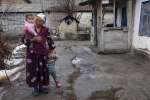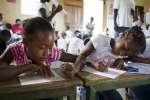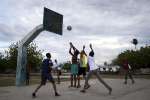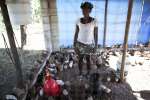UNHCR publication for CIS Conference (Displacement in the CIS) - In legal limbo: asylum-seekers and statelessness
Refugees Magazine, 1 May 1996
Refugees and asylum-seekers
The dissolution of the Soviet Union and the outbreak of armed conflicts and ethnic clashes in several CIS countries have resulted in forced population displacements (including refugees and internally displaced people) that are unprecedented – both in terms of the number of people affected and the complexity of the issues.
In addition, all CIS countries are confronted with the new challenge of coping with the arrival of asylum-seekers from non-CIS countries (in particular Afghanistan, Iraq, Somalia, Ethiopia, Angola and Zaire). Afghans – as many as 200,000 of whom are estimated to be living in CIS countries – constitute the largest group of non-CIS asylum-seekers.
The refugee population in the CIS region has a number of unusual features, linked to the sudden and dramatic change of identity of the state in which they are living. They include a large group of 'refugees sur place' – people who arrived in the USSR either by choice, or as a result of bilateral agreements, and were subsequently stranded in the successor states as a result of changes within their own country, or in the relationship between their home country and their newly metamorphosed host country. Examples of refugees sur place include former students from countries that were within the Soviet sphere of influence, children of communist Afghan officials (including many orphans) and North Korean timber workers.
As of mid-April, only four CIS countries had acceded to the 1951 Convention on Refugees and its 1967 Protocol (with a fifth, Kyrgyzstan, on the verge of doing so). Only four have adopted sound national legislation on refugees. However, even for these states, the implementation of international obligations deriving from accession to the 1951 Convention and/or the adoption of national refugee legislation poses a serious problem: as yet, none of the countries possesses sufficient institutional capacity to fully translate the national and international laws into consistent everyday practice.
The consequence of this absence of sound legislation, or its imperfect implementation, is that, in almost all CIS countries (with the possible exception of Tajikistan), non-CIS asylum-seekers do not have access to a refugee status determination procedure, do not enjoy the protection of their asylum country, and have no legal status nor any social or economic rights.
CIS refugees have in general found protection in their country of nationality (for instance ethnic Armenians from Azerbaijan moving to Armenia), and governments are in the process of identifying durable solutions for each group. However, in many CIS countries, existing regulations that restrict freedom of movement and choice of place of residence constitute a major obstacle to the successful local integration of refugees and IDPs from within the CIS region, as well as refugees from non-CIS countries.
Statelessness
In December 1991, Soviet citizenship ceased to exist, leaving 287 million people in need of a new identity. One of the primary tasks of the newly independent states has been to define precisely who their citizens are, and to establish new rules for the granting of citizenship.
CIS countries have, broadly speaking, gone about this in two different ways. Several governments (Russia, Belarus, Ukraine, Georgia and to some extent Moldova) have chosen the so-called 'zero option,' according to which all those who were permanent residents when the new law entered into force were counted as citizens. Some other governments (including most of the Central Asian states and Azerbaijan) have employed the concept of nationality used by the former USSR, and only granted citizenship to those people who had been considered as nationals before independence.
Given the different criteria used by the successor states of the USSR for the constitution of their citizenry and the granting of citizenship – criteria that are sometimes conflicting or contradictory – some groups of people have been left out and are, as a result, effectively stateless. This is the current position facing some of the formerly deported peoples, for example some Meskhetians and Crimean Tatars, who had not managed to return to their country of origin before the Soviet Union dissolved.
It is also the case for certain groups living in countries where the criterion of the previous nationality has been used: as they were not considered part of the national group, they have not been granted the citizenship of the successor state. If their state of ancestral origin belongs to the 'zero option' group, and they were not permanent residents at the time of entry into force of the citizenship law, they fail to qualify for citizenship there as well. Some Russians, Ukrainians and Belarusians living in Central Asia are among those who fall into this category.
Statelessness can result in displacement, but only when it is combined with other factors (such as conflict, a rise in inter-ethnic tensions or economic insecurity). Because of the lack of legal protection from clearly identified national authorities, stateless people may be tempted to move in order to find such protection elsewhere – one of the reasons why many people have been leaving Central Asia. However, others in the same situation prefer to stay, either because they do not feel particularly threatened, or because they feel a move will leave them financially worse off.
CIS countries that have ratified selected international instruments
1951 Convention and/or 1967 Protocol Relating to the Status of Refugees
Armenia
Azerbaijan
Russian Federation
Tajikistan
1954 Convention Relating to the Status of Stateless Persons
1961 Convention on the Reduction of Statelessness
Armenia
1966 International Covenant on Civil and Political Rights
1966 International Covenant on Economic, Social and Cultural Rights
Armenia
Azerbaijan
Belarus
Georgia
Kyrgyzstan
Moldova
Russian Federation
Ukraine
Uzbekistan
1949 Geneva Conventions
1989 Convention on the Rights of the Child
All CIS countries















































